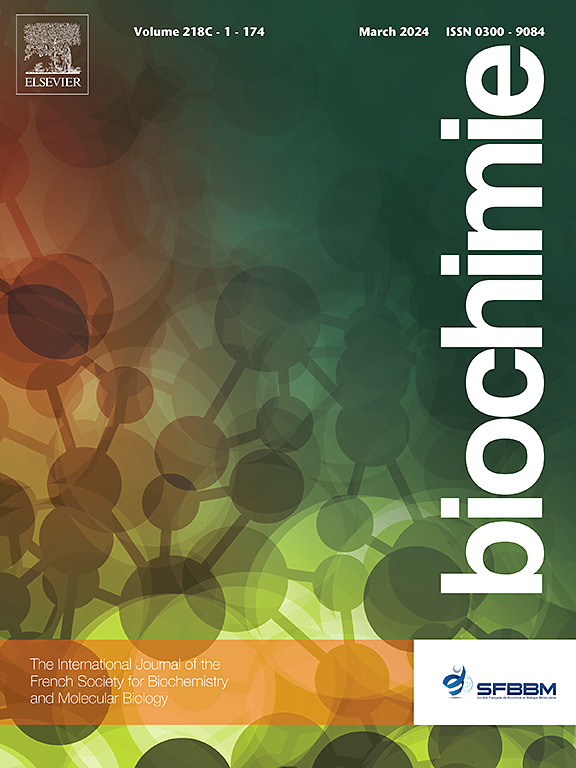Biochemical and proteomic profiling reveals potent proteolytic activity in the venom of Erythrolamprus melanotus (Shaw's dark ground snake, Xenodontini)
IF 3
3区 生物学
Q2 BIOCHEMISTRY & MOLECULAR BIOLOGY
引用次数: 0
Abstract
We describe here the Duvernoy's venom gland organization and biochemical and proteomic analyses of venom from the Colombian colubrid snake Erythrolamprus melanotus. Histological analysis indicated a serous venom gland distinct from the mucous supralabial gland. SDS-PAGE of the venom revealed >15 bands (∼15 kDa–∼200 kDa) and gelatin zymography revealed potent proteolytic activity; zymographic activity towards casein was considerably less. RP-HPLC yielded 16 peaks, several of which contained proteases, as assessed by gelatin zymography. Enzymatic assays using azocasein, azocoll and hide powder azure confirmed the proteolytic activity. The venom selectively degraded the Aα-chain of fibrinogen without affecting the Bβ and γ-chains (assessed by SDS-PAGE). All proteolytic activity was inhibited by EDTA (metalloproteinase inhibitor) but not by AEBSF (serine proteinase inhibitor). The venom had no l-amino acid oxidase, esterase, and PLA2 activities. Proteomic analysis indicated the presence primarily of snake venom metalloproteinases (SVMP), snake venom matrix metalloproteinases (svMMP) and cysteine-rich secretory proteins (CRiSP). SVMP and svMMP were the major components, indicating that this venom is rich in proteases, in agreement with the findings for zymography and enzymatic assays. This study provides the first characterization of Colombian E. melanotus venom and highlights its rich content of metalloproteinases and potent proteolytic activity.
生化和蛋白质组学分析显示,黑腹蛇(肖氏黑地蛇,Xenodontini)的毒液具有强大的蛋白水解活性。
本文描述了哥伦比亚杂交蛇Erythrolamprus melanotus毒液的Duvernoy毒液腺组织和生化和蛋白质组学分析。组织学分析显示浆液性毒液腺不同于黏液性唇上腺。毒液的SDS-PAGE显示出bbb15条带(~ 15 kDa至~ 200 kDa),明胶酶谱图显示出强大的蛋白水解活性;对酪蛋白的酶谱活性明显降低。RP-HPLC得到16个峰,其中几个含有蛋白酶,通过明胶酶谱法进行评估。用偶氮酪蛋白、偶氮胶体和兽皮粉天蓝进行酶解实验,证实了该蛋白的水解活性。毒液选择性地降解纤维蛋白原的a α-链,而不影响Bβ和γ-链(SDS-PAGE评价)。金属蛋白酶抑制剂EDTA对所有蛋白水解活性均有抑制作用,而丝氨酸蛋白酶抑制剂AEBSF无抑制作用。毒液不含l -氨基酸氧化酶、酯酶和PLA2活性。蛋白质组学分析表明,主要存在蛇毒金属蛋白酶(SVMP)、蛇毒基质金属蛋白酶(svMMP)和富含半胱氨酸分泌蛋白(CRiSP)。SVMP和svMMP是主要成分,表明该毒液富含蛋白酶,与酶谱分析和酶分析结果一致。本研究首次对哥伦比亚黑鳗毒液进行了鉴定,强调了其丰富的金属蛋白酶含量和强大的蛋白水解活性。
本文章由计算机程序翻译,如有差异,请以英文原文为准。
求助全文
约1分钟内获得全文
求助全文
来源期刊

Biochimie
生物-生化与分子生物学
CiteScore
7.20
自引率
2.60%
发文量
219
审稿时长
40 days
期刊介绍:
Biochimie publishes original research articles, short communications, review articles, graphical reviews, mini-reviews, and hypotheses in the broad areas of biology, including biochemistry, enzymology, molecular and cell biology, metabolic regulation, genetics, immunology, microbiology, structural biology, genomics, proteomics, and molecular mechanisms of disease. Biochimie publishes exclusively in English.
Articles are subject to peer review, and must satisfy the requirements of originality, high scientific integrity and general interest to a broad range of readers. Submissions that are judged to be of sound scientific and technical quality but do not fully satisfy the requirements for publication in Biochimie may benefit from a transfer service to a more suitable journal within the same subject area.
 求助内容:
求助内容: 应助结果提醒方式:
应助结果提醒方式:


